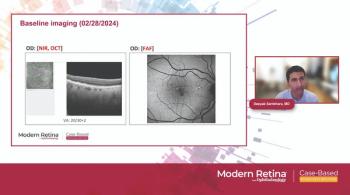
Innovative suprachoroidal injection reduces diabetic retinopathy complications
Breakthrough suprachoroidal injection technique offers promising treatment for diabetic retinopathy, reducing visual threatening complications from 37% to 4% with minimal inflammation and office-based procedure.
David S. Boyer, MD, discusses a new approach to treating
The study examined 3 dosing regimens (2.5e-11, 5e-11, and 1e-12) across different patient groups with diabetic retinopathy. The most compelling results emerged in the high-dose treatment, which remarkably reduced visual threatening complications from 37% to just 4%. This represents a transformative potential for patient outcomes.
"So I think that we're getting to the point where these suprachoroidal injections are very, very helpful. They may be able to reduce the number of injections, and the safety was good," Boyer said. "Topical drops were all that was necessary to reduce any intraocular inflammation. In fact, in the highest dose, there was no interactive inflammation when topical drops were utilized. So I think that as we go, and I don't think this is the last dosing, I think you can go higher, and if you go higher, we may be able to get even longer term and better results. So I'm hopeful that the suprachoroidal space will be evaluated, because it is easy to do in the office."
Key findings include sustained vision maintenance, improved diabetic retinopathy severity, and reduced need for rescue treatments. Notably, the highest dose demonstrated exceptional safety, with topical drops effectively managing any potential inflammation. Patients experienced not just stabilization but potential improvement in their condition, with some showing up to two steps of retinopathy severity improvement.
The suprachoroidal space emerges as a promising alternative to more invasive delivery methods like subretinal or intravitreal injections. Its office-based nature, minimal surgical risks, and potential for long-lasting treatment make it a significant advancement in ophthalmological care.
Boyer remains optimistic about future developments, suggesting that higher doses could yield even more promising long-term results. The research highlights 2 key programs – the 150 program and the Adverum program – with ongoing refinements to maximize safety and efficacy.
This approach represents a potential paradigm shift in treating retinal conditions, offering hope for patients through a safer, more convenient, and potentially more effective treatment methodology.
Newsletter
Keep your retina practice on the forefront—subscribe for expert analysis and emerging trends in retinal disease management.








































